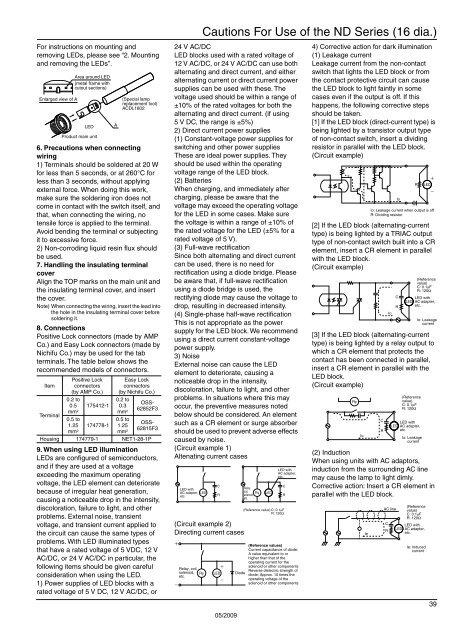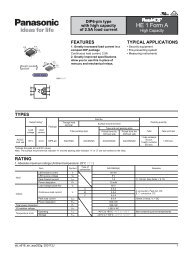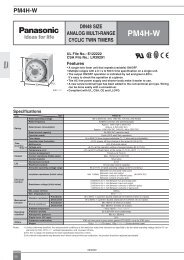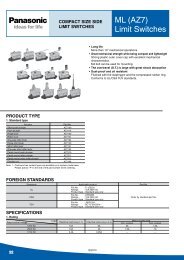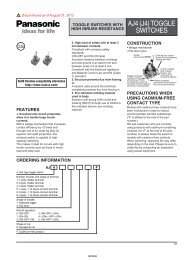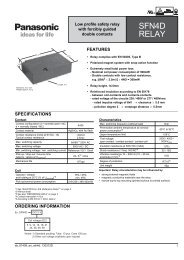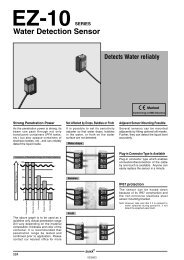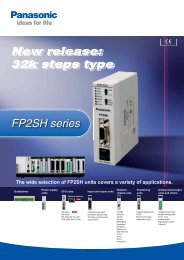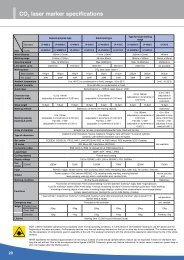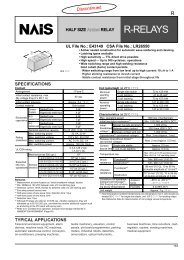T A B L E O F C O N T E N T S - Panasonic Electric Works Europe AG
T A B L E O F C O N T E N T S - Panasonic Electric Works Europe AG
T A B L E O F C O N T E N T S - Panasonic Electric Works Europe AG
Create successful ePaper yourself
Turn your PDF publications into a flip-book with our unique Google optimized e-Paper software.
For instructions on mounting and<br />
removing LEDs, please see “2. Mounting<br />
and removing the LEDs”.<br />
Enlarged view of A<br />
6. Precautions when connecting<br />
wiring<br />
1) Terminals should be soldered at 20 W<br />
for less than 5 seconds, or at 260°C for<br />
less than 3 seconds, without applying<br />
external force. When doing this work,<br />
make sure the soldering iron does not<br />
come in contact with the switch itself, and<br />
that, when connecting the wiring, no<br />
tensile force is applied to the terminal.<br />
Avoid bending the terminal or subjecting<br />
it to excessive force.<br />
2) Non-corroding liquid resin flux should<br />
be used.<br />
7. Handling the insulating terminal<br />
cover<br />
Align the TOP marks on the main unit and<br />
the insulating terminal cover, and insert<br />
the cover.<br />
Note) When connecting the wiring, insert the lead into<br />
the hole in the insulating terminal cover before<br />
soldering it.<br />
8. Connections<br />
Positive Lock connectors (made by AMP<br />
Co.) and Easy Lock connectors (made by<br />
Nichifu Co.) may be used for the tab<br />
terminals. The table below shows the<br />
recommended models of connectors.<br />
Item<br />
Terminal<br />
Area around LED<br />
(metal frame with<br />
cutout sections)<br />
LED<br />
Product main unit<br />
Positive Lock<br />
connectors<br />
(by AMP Co.)<br />
0.2 to<br />
0.5 175412-1<br />
mm 2<br />
0.5 to<br />
1.25 174778-1<br />
mm 2<br />
Easy Lock<br />
connectors<br />
(by Nichifu Co.)<br />
0.2 to<br />
0.3<br />
mm 2<br />
0.5 to<br />
1.25<br />
mm 2<br />
OSS-<br />
62852F3<br />
OSS-<br />
62815F3<br />
Housing 174779-1 NET1-28-1P<br />
9. When using LED illumination<br />
LEDs are configured of semiconductors,<br />
and if they are used at a voltage<br />
exceeding the maximum operating<br />
voltage, the LED element can deteriorate<br />
because of irregular heat generation,<br />
causing a noticeable drop in the intensity,<br />
discoloration, failure to light, and other<br />
problems. External noise, transient<br />
voltage, and transient current applied to<br />
the circuit can cause the same types of<br />
problems. With LED illuminated types<br />
that have a rated voltage of 5 VDC, 12 V<br />
AC/DC, or 24 V AC/DC in particular, the<br />
following items should be given careful<br />
consideration when using the LED.<br />
1) Power supplies of LED blocks with a<br />
rated voltage of 5 V DC, 12 V AC/DC, or<br />
A<br />
(Special lamp<br />
replacement tool)<br />
ACDL1802<br />
Cautions For Use of the ND Series (16 dia.)<br />
24 V AC/DC<br />
LED blocks used with a rated voltage of<br />
12 V AC/DC, or 24 V AC/DC can use both<br />
alternating and direct current, and either<br />
alternating current or direct current power<br />
supplies can be used with these. The<br />
voltage used should be within a range of<br />
±10% of the rated voltages for both the<br />
alternating and direct current. (if using<br />
5 V DC, the range is ±5%)<br />
2) Direct current power supplies<br />
(1) Constant-voltage power supplies for<br />
switching and other power supplies<br />
These are ideal power supplies. They<br />
should be used within the operating<br />
voltage range of the LED block.<br />
(2) Batteries<br />
When charging, and immediately after<br />
charging, please be aware that the<br />
voltage may exceed the operating voltage<br />
for the LED in some cases. Make sure<br />
the voltage is within a range of ±10% of<br />
the rated voltage for the LED (±5% for a<br />
rated voltage of 5 V).<br />
(3) Full-wave rectification<br />
Since both alternating and direct current<br />
can be used, there is no need for<br />
rectification using a diode bridge. Please<br />
be aware that, if full-wave rectification<br />
using a diode bridge is used, the<br />
rectifying diode may cause the voltage to<br />
drop, resulting in decreased intensity.<br />
(4) Single-phase half-wave rectification<br />
This is not appropriate as the power<br />
supply for the LED block. We recommend<br />
using a direct current constant-voltage<br />
power supply.<br />
3) Noise<br />
External noise can cause the LED<br />
element to deteriorate, causing a<br />
noticeable drop in the intensity,<br />
discoloration, failure to light, and other<br />
problems. In situations where this may<br />
occur, the preventive measures noted<br />
below should be considered. An element<br />
such as a CR element or surge absorber<br />
should be used to prevent adverse effects<br />
caused by noise.<br />
(Circuit example 1)<br />
Altenating current cases<br />
LED with<br />
AC adapter,<br />
etc.<br />
(Circuit example 2)<br />
Directing current cases<br />
Relay, coil,<br />
solenoid,<br />
etc.<br />
LED<br />
Ry<br />
C<br />
R<br />
LED<br />
05/2009<br />
Diode<br />
Relay,<br />
coil,<br />
solenoid,<br />
etc.<br />
Ry<br />
LED<br />
LED with<br />
AC adapter,<br />
etc.<br />
C<br />
R<br />
(Reference value) C: 0.1μF<br />
R: 120Ω<br />
(Reference values)<br />
Current capacitance of diode:<br />
A value equivalent to or<br />
higher than that of the<br />
operating current for the<br />
solenoid or other components<br />
Reverse dielectric strength of<br />
diode: Approx. 10 times the<br />
operating voltage of the<br />
solenoid or other components<br />
4) Corrective action for dark illumination<br />
(1) Leakage current<br />
Leakage current from the non-contact<br />
switch that lights the LED block or from<br />
the contact protective circuit can cause<br />
the LED block to light faintly in some<br />
cases even if the output is off. If this<br />
happens, the following corrective steps<br />
should be taken.<br />
[1] If the LED block (direct-current type) is<br />
being lighted by a transistor output type<br />
of non-contact switch, insert a dividing<br />
resistor in parallel with the LED block.<br />
(Circuit example)<br />
[2] If the LED block (alternating-current<br />
type) is being lighted by a TRIAC output<br />
type of non-contact switch built into a CR<br />
element, insert a CR element in parallel<br />
with the LED block.<br />
(Circuit example)<br />
[3] If the LED block (alternating-current<br />
type) is being lighted by a relay output to<br />
which a CR element that protects the<br />
contact has been connected in parallel,<br />
insert a CR element in parallel with the<br />
LED block.<br />
(Circuit example)<br />
Ry<br />
Io<br />
(2) Induction<br />
When using units with AC adaptors,<br />
induction from the surrounding AC line<br />
may cause the lamp to light dimly.<br />
Corrective action: Insert a CR element in<br />
parallel with the LED block.<br />
Ie<br />
Io<br />
Io: Leakage current when output is off<br />
R: Dividing resistor<br />
C<br />
R<br />
Io<br />
C<br />
R<br />
LED<br />
AC line<br />
C<br />
R<br />
R<br />
LED<br />
(Reference<br />
value)<br />
C: 0.1μF<br />
R: 120Ω<br />
LED with<br />
LED AC adapter,<br />
etc.<br />
(Reference<br />
value)<br />
C: 0.1μF<br />
R: 120Ω<br />
LED with<br />
AC adapter,<br />
etc.<br />
LED<br />
Io: Leakage<br />
current<br />
(Reference<br />
value)<br />
C: 0.1μF<br />
R: 120Ω<br />
LED with<br />
AC adapter,<br />
etc.<br />
Ie: Induced<br />
current<br />
Io: Leakage<br />
current<br />
39


